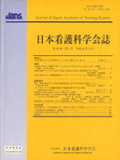Japanese
English
- 販売していません
- Abstract 文献概要
- 参考文献 Reference
- サイト内被引用 Cited by
要旨
本研究は,訪問看護師が行うグリーフケア,看護師が認識した家族介護者のアウトカム,看護師のアウトカムの構成概念を帰納的に明らかにすることを目的とし,各尺度を作成し,全国の訪問看護ステーションに勤務する看護師への郵送による自記式質問紙調査を実施した.
質問紙の有効回答(率)は1442(76.1%)であった.グリーフケア尺度は3つに分かれ,療養生活開始から終末期のグリーフケア尺度は3因子構造16項目[α=0.93],臨終時のグリーフケア尺度は1因子構造5項目[α=0.66],看取り後のグリーフケアは3因子構造21項目[α=0.93]になった.グリーフケアの家族介護者のアウトカム尺度は4因子構造19項目[α=0.81],看護師のアウトカム尺度は4因子構造13項目[α=0.73]になった.
看護師が行うグリーフケアは,療養生活開始から終末期のグリーフケア,臨終時のグリーフケア,看取り後のグリーフケアの3つが継続的に実施されることで,ケアの実施が相互に高まっていることが示された.
Abstract
The purpose of this study was to clarify inductively-derived concepts comprising grief care provided by visiting nurses;nurses' perspectives of family caregivers' outcomes and nurses' outcomes. Data was generated from a mail survey using an original researcher developed self-administered questionnaire to visiting nurses employed at the visiting nurse stations throughout Japan, which were established by the Long-term Care Insurance Law.
Valid responses included 1442(76.1%) nurses. Factor analysis yielded three caregiving scales:grief care from beginning of home care to the terminal period(3 factors, 16 items)[α=0.93];grief care at deathbed(1 factors 5 items)[α=0.66] and grief care after the patient's death(3 factors, 21 items)[α=0.93]. There were two outcome scales:family caregivers' outcomes(4 factors, 19 items)[α=0.81] and nurses' outcomes(4 factors, 13 items)[α=0.73].
Grief care provided by nurses was divided into three periods. The continual implementation of grief care from beginning of home care to the terminal period, at deathbed, and after the patient's death was shown to mutually enhance care implementation.
Copyright © 2011, Japan Academy of Nursing Science. All rights reserved.


